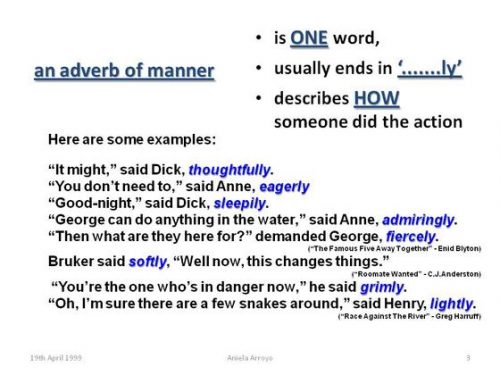
Everyone likes a label but no one likes to be labelled!
Food labels, clothing labels, price labels and word class labels. How does this technicality apply to adverb and adverbial and their differences?
Word class labels, a language form of labelling, performs the function of labelling a grammatical form, it labels the verb.
Taylor Caldwell, award winning author, said:
‘Giving a phenomenon a label does not explain it.’
How true is that of the adverb and adverbial? They are labelled differently in terms of their role in the English language. The adverb is a type of word, like nouns, verbs, adjectives and other parts of speech. An adverb can be adverbial but adverbial is not necessarily an adverb. Confusing, yes but as they are discussed and analysed their functions and roles in sentence construction becomes apparent. They share the same root word but that does not make them the same. Adverbs are a word class – simple to understand. Adverbials are sentence modifiers and are a functional aspect of sentence construction. The adverbial phenomenon has an operational role to perform a more complex and varied part to play in sentences.
The simple part first is to understand the adverb:
A simple way to explain the adverb is as a single word that fills the role of a word class, a grammatical form. Its purpose is to modify the verb by showing these characteristics:
- Manner – how did something happen for example quickly slowly or sadly.
She ate her food quickly.
- place – where did something take place for example ***
They drove their car there.
- Time – when was the action for example early, daily, nightly?
The boy is sleeping now.
In sentences if there is more than one adverb they follow the order of manner, place and time.
All these examples of adverbs usually end in the letter ‘y’. That is a sure fire signal that there is an adverb labelling something in a sentence. It is interesting to note that the meaning of an adverb can change depending on its position in a sentence.
For example:
He answered the question foolishly. (Foolishly – in a silly manner)
He foolishly answered the question. (His action was foolish)
Now you need to put your clever cap on to understand all the facets of Adverbials:
Adverbial seems to be a more complex topic. Adverbial phrases have a functional role. They modify a sentence but there are a number of varieties of adverbial phrases. They do have the function of expressing manner, place, time and degree. This creates a similarity between themselves and the adverb. However, adverbials can be written in a number of different ways and placed in different places in a sentence. They can be explained in the following ways with examples to lend further understanding of their different roles.
Adverbial clauses explaining manner, time and place.
- He ran as quickly as possible. (manner)
- They have lived in this old town for over twenty years. (time)
- The cat was sleeping under the table. (place)
These adverbial clauses can appear anywhere in a sentence. Their function is to explain how, where, why and when. They include a subject and a verb.
- How – the phrase is with a song in my heart.
I will enter the holiday resort with a song in my heart.
- Where – the phrase is somewhere over the rainbow.
True happiness can be found somewhere over the rainbow.
- Why – to understand better, lest she forget.
Mary put flowers in the cemetery every day lest she forget the memory of her mother.
- When – after the sunset, in an hour.
You can take the cake out of the oven in an hour and it should be ready for tea.
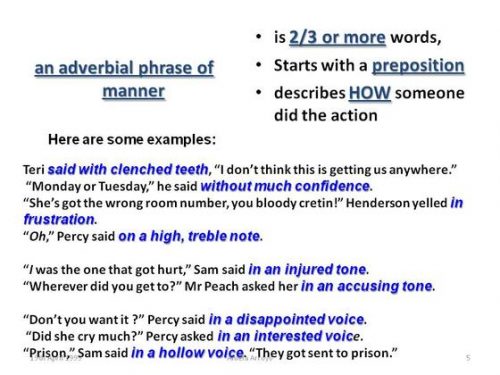
Adverbial phrases and their different functions:
- Mary called immediately. (adverb)
- Sally answered in English. (prepositional phrase}
- John answered in English because he had a foreign visitor. (Adverbial clause)
- Peter put the fish in the water. (Adverbial compliment. The sentence has no meaning without the adverbial compliment. Peter put the fish – cannot stand alone.)
- Chris and Ted helped dig in the garden. (Adverbial adjuncts are part of the meaning of the sentence but if they are left off the sentence it still makes sense.)
- John helped me with my reading; therefore, I was able to finish my homework. (Adverbial conjunct joins two parts of the sentence.)
- Surprisingly, she managed to ride the horse. (Disjunctives make comments on the meaning of the sentence.
- Mother said she may not ride her bike and never cycle in a race. Negators, not and never are considered to be negators. (They are adverbs that negate the adverbial clause.)
- What the hell are you saying? You jolly well know smoking is not allowed.
(Expletives may also take up an adverbial syntactic function. They serve as intensifiers enhancing the content.)
Sentence placement of adverbials.
The adverbials can vary according to the writer’s choice.
There is sentence initial – Yesterday I swam in the sea.
There is sentence final – I swam in the sea yesterday.
There is pre-verbial – I always enjoy my dinner in the evening.
There is post-verbial – I drank quickly at the water fountain to cool down.
Then there is within the verb group – Mary has never won a prize.
Introductory Adverbial clauses and phrases.
The ‘introductories’ can vary. They are known as dependent clauses because they can’t stand alone.
Examples of introductory phrases and clauses:
In the centre of London, the number of people who travelled by bus has increased.
(Adverbial phrase sets a place – centre of London)
After twelve years, of therapy, my psychiatrist said I was cured of my phobia.
(Adverbial phrase sets the time – after twelve years)
In ancient Rome, bathing in public was very acceptable.
(Adverbial phrase sets both time and place – ancient Rome)
It is good practise to use a comma after and introductory adverbial phrase.
The adverbial adjunct is a type of adverbial that adds more information to a sentence but it differs from others because if it were to be left off the rest of the sentence still makes sense.
For example:
I dropped my bag, next to my seat, and sat down.
Next to my seat is the adverbial adjunct and if it is left out the sentence will still make sense. It will say – I dropped my bag and sat down.
Adverbial adjuncts can also add conditions to a sentence.
A condition explains if ‘this happens then that happens.’
For example:
Mary left directions to the camp for me to read in the event of her getting lost.
Other adverbial adjuncts make a concession phrase in the sentence.
A conditional adjunct adverbial phrase explains if this happens, still that happens.
For example:
Despite all their best efforts the lawn mower is still broken.
Finally, where do adverbs and adverbials get placed in a sentence? They both belong to the predicate part of the sentence. They may be placed at the beginning of the sentence provided they don’t separate the subject from the verb.
The adverbial phrase is the term for two or more words which play the role of an adverb. This is how they can change the meaning of a simple sentence.
- Normal adverb.
John can sit quietly.
- Adverbial phrase.
John can sit in silence.
- Adverbial clause
John can sit like a yogi meditating.
These examples are all adverbials explaining the manner of doing something.
How does John sit?
It is worth noting that when a multi word adverb contains a subject and a verb it is an adverbial clause as opposed to a phrase.
In the final analysis should we agree with Taylor Caldwell?
‘Giving a phenomenon a label does not explain it’
Has labelling adverbs as a word class with a grammatical form helped to differentiate them from an adverbial that has a grammatical function. There is the bottom line then – form or function. Has the analysis of these forms and functions helped with understanding the English use of adverbs as fairly simple and adverbials quite the opposite and more involved. The two words sounding similar but not the same are part of a phenomenon that challenges the labelling process and deciding on their differences. Now that the differences have been explained and examples given it is perhaps an obvious conclusion. An adverb can be an adverbial but an adverbial is so much more than an adverb. Their labels tell us that they are actually, in terms of their usefulness in word analysis and sentence building, not really in the same calibre of word value.

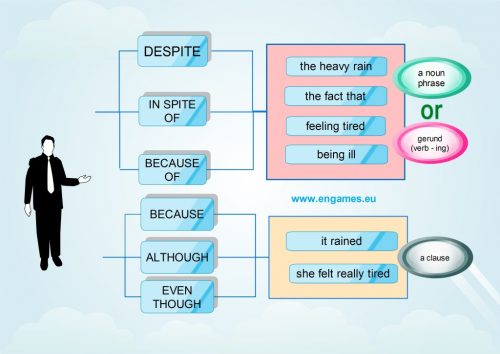
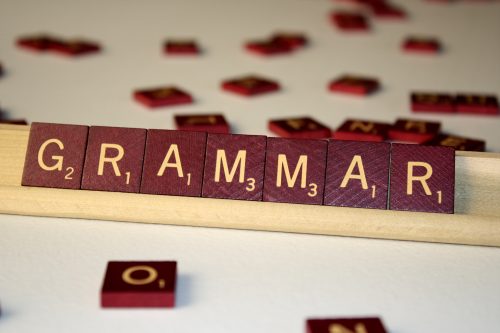


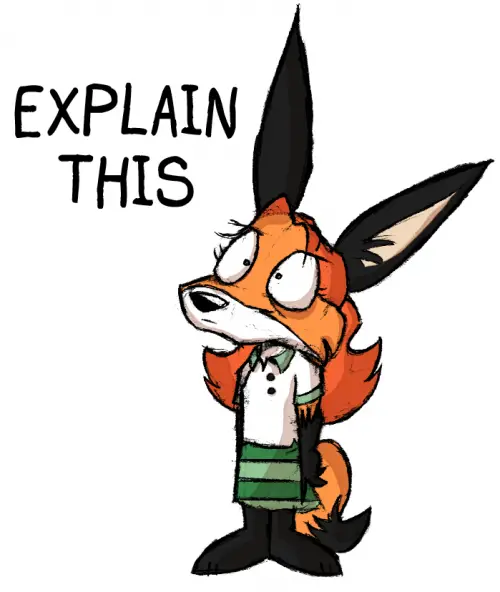





Leave a Reply